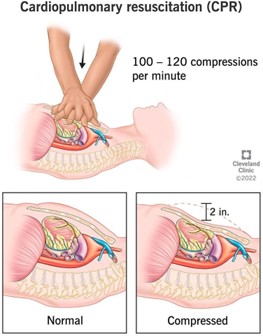The nurse is caring for a client who recently had surgery on her left hip. What should be the priority teaching for the patient after surgery to prevent complications?
Use of the incentive spirometer
Breathing rapidly to prevent pneumonia.
There is no need to teach the patient after surgery.
Use of chest tube
The Correct Answer is A
The use of an incentive spirometer is essential after surgery to prevent complications such as pneumonia and atelectasis. Atelectasis is the collapse of air sacs in the lungs, which can occur after surgery due to decreased respiratory effort and shallow breathing. An incentive spirometer helps the patient take deep breaths and increase their lung volume, preventing these complications.
Breathing rapidly to prevent pneumonia (option b) is not recommended as it can lead to hyperventilation and other respiratory complications.
Option c is incorrect because patient education is a crucial aspect of post-operative care, and the patient needs to be aware of the potential complications and how to prevent them.
The use of a chest tube (option d) is not usually required after hip surgery, and it is not a priority teaching for the patient.
Nursing Test Bank
Naxlex Comprehensive Predictor Exams
Related Questions
Correct Answer is C
Explanation
CPR (Cardiopulmonary Resuscitation) is a life-saving procedure that is performed when a person's heart has stopped beating. It involves chest compressions and rescue breathing to restore the circulation of oxygenated blood to the brain and other vital organs. The timely initiation of CPR can significantly increase the chances of a patient's survival.
In a healthcare setting, UAPs/CNAs are often trained to provide basic life support, including initiating CPR, until a healthcare provider arrives. However, giving IV epinephrine, intubating the patient, and obtaining arterial blood gases are all advanced medical procedures that require specialized training and expertise. These actions should only be performed by trained healthcare providers, such as registered nurses, physicians, or respiratory therapists, and cannot be delegated to UAPs/CNAs.

Correct Answer is A
Explanation
A. Respiratory acidosis.
COPD is a chronic lung disease that can lead to an accumulation of carbon dioxide (CO2) in the body. This can cause respiratory acidosis, a condition in which the blood pH is lower than normal due to an excess of CO2.
In respiratory acidosis, the partial pressure of carbon dioxide (PaCO2) in the blood is increased and the pH is decreased. The kidneys atempt to compensate for the acidosis by excreting more acid in the urine and retaining more bicarbonate, but this compensation is usually not enough to fully correct the problem.
Metabolic alkalosis (option B) is a condition in which the blood pH is higher than normal due to an excess of bicarbonate in the blood. This is usually caused by loss of acid from the body, such as through vomiting or use of diuretics.
Respiratory alkalosis (option C) is a condition in which the blood pH is higher than normal due to a decrease in PaCO2. This can be caused by hyperventilation, which leads to excessive elimination of CO2 from the lungs.
Metabolic acidosis (option D) is a condition in which the blood pH is lower than normal due to an excess of acid in the blood. This can be caused by a variety of factors, including kidney failure or lactic acidosis.
Whether you are a student looking to ace your exams or a practicing nurse seeking to enhance your expertise , our nursing education contents will empower you with the confidence and competence to make a difference in the lives of patients and become a respected leader in the healthcare field.
Visit Naxlex, invest in your future and unlock endless possibilities with our unparalleled nursing education contents today
Report Wrong Answer on the Current Question
Do you disagree with the answer? If yes, what is your expected answer? Explain.
Kindly be descriptive with the issue you are facing.
